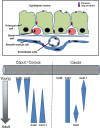Physiological roles of connexins and pannexins in reproductive organs
- PMID: 26100514
- PMCID: PMC11114083
- DOI: 10.1007/s00018-015-1965-4
Physiological roles of connexins and pannexins in reproductive organs
Abstract
Reproductive organs are complex and well-structured tissues essential to perpetuate the species. In mammals, the male and female reproductive organs vary on their organization, morphology and function. Connectivity between cells in such tissues plays pivotal roles in organogenesis and tissue functions through the regulation of cellular proliferation, migration, differentiation and apoptosis. Connexins and pannexins can be seen as major regulators of these physiological processes. In the present review, we assembled several lines of evidence demonstrating that these two families of proteins are essential for male and female reproduction.
Conflict of interest statement
The authors declare that the research was conducted in the absence of any commercial or financial relationship that could be construed as a potential conflict of interest.
Figures




References
-
- Clermont Y. Kinetics of spermatogenesis in mammals: seminiferous epithelium cycle and spermatogonial renewal. Physiol Rev. 1972;52(1):198–236. - PubMed
-
- Pointis G, Segretain D. Role of connexin-based gap junction channels in testis. Trends Endocrinol Metab. 2005;16(7):300–306. - PubMed
-
- Shynlova O, Tsui P, Jaffer S, Lye SJ. Integration of endocrine and mechanical signals in the regulation of myometrial functions during pregnancy and labour. Eur J Obstet Gynecol Reprod Biol. 2009;144(Suppl 1):S2–S10. - PubMed
-
- Albrecht JL, Atal NS, Tadros PN, Orsino A, Lye SJ, Sadovsky Y, Beyer EC. Rat uterine myometrium contains the gap junction protein connexin45, which has a differing temporal expression pattern from connexin43. Am J Obstet Gynecol. 1996;175(4 Pt 1):853–858. - PubMed
Publication types
MeSH terms
Substances
LinkOut - more resources
Full Text Sources

